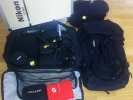Blog
NIKKOR 800mm f/5.6E – a field review by Roy Mangersnes (19.09.2013)
The good guys at Nikon Norway was friendly and crazy enough to lend me the new (in April-May 2013) Nikkor 800mm f/5,6E FL ED VR lens to try on my latest expedition to the Arctic. This time I travelled as a host on a specialized photographic expedition organized by WildPhoto Travel, and we spent 10 days in the Arctic oceans around Svalbard.
I have never been a big fan of technical reviews, though I do take a sneak peak every now and then. Therefore, I wanted to give you my initial impression of this new Nikon “power tool”.
To give you an insight of the conditions I was working under I will give you some hard facts. I was hosting the trip with 12 guests on a small expedition vessel departing from Longyearbyen. We spent 10 days circling the Svalbard archipelago in the arctic summer. The conditions varied from plus 10 to 1 degree Celcius, some rain and a lot of salt-water spray (sorry Nikon). I shot about 3500 images with the lens and it was my preferred tool during the entire trip. I also carried the 300mm f/2,8 with converters and shorter options. All images with the 800 were shot with the Nikon D4 camera.
Normally I use the Nikkor 500mm f/4 and I am very pleased with the results it gives me. I have also used the 600mm f/4, which is a brill lens, and in the early days I have tried the Canon 800mm.
To be honest I was getting rather cold feet on the flight, leaving my favourite 500mm at home, but I really wanted to give this beast a chance.
First I found the lens rather heavy to work with, being used to 500mm, but I do realize it is almost 0,5 kilogram lighter then the 600mm f/4 and as a travelling photographer I really appreciate that Nikon is moving in that direction. A lot of the photography is done from the vessel itself, but we also use Zodiacs to get the low angel. From the ship I used the Sachtler tripod most of the time, but I also used it handheld with and without alternative support. From the Zodiac I did not have the option of tripod and also being the Zodiac driver I had to trust in my ability to handhold the 800mm, supported only by the vibration reduction.
From the first shots of Little Auks I was really impressed with the sharpness of this lens. Based on my previous stated concern I did not expect revolution, but I must admit this blew me away. Displayed on my 15” Macbook Pro Retina screen the images really pop, and the detail is stunning even at f/5,6.
Just working the focal length was a bit unfamiliar but after a couple of days it felt natural to work with such magnification, and it felt really good. Especially when approaching courting Polar Bears in the pack ice the 800mm came really handy. Tight framing of the action was no problem without disturbing the behaviour of the animals.
I did also test the autofocus on birds but I must admit I was struggling to follow them as they flew by. However, I will not put all the blame on the lens itself as it seems to catch the subject extremely fast, but it was hard to follow the birds as they flew by with a tight crop. On a couple of occasions we had some bird action near the boat and I was able to capture this rather well even with this lens. With more practice this will probably become easier with time. Note that autofocus will not work optimally until the latest firmware has been uploaded to the D4 (v1.05).
One might argue that f/5,6 is not enough to shoot wildlife but with the ISO capabilities of the latest cameras this is no problem in my opinion. I usually find myself shooting at 5,6 or higher anyway to get more depth of field and detail in the subjects.
A 800mm lens would probably seem enough for most people, but Nikon have added a 1,25 converter in the case as well. This is a highly specialized piece of equipment were every converter is perfectly matched with its lens. This I had to try and what else was there to shot then Walruses? I sett up my tripod and worked with tight crops of these massive creatures with 1000mm @ f/7,1. I did find the lens a bit soft on full opening but by stopping down to f/9 or higher the images were back to sharp - sharp! Very impressive and very handy.
To conclude I am very impressed with this lens and I cannot wait to get my own!
Despite being comparably lightweight the 800mm do fill some space in the bag. During the last months I have been travelling with the F-stop Literoom Roller to South-Africa and twice to Svalbard. This bag has really made my travelling easier and on my latest trip I filled it with Nikon D4 and D800 bodies, Nikkor 800mm f/5,6, 300mm f/2,8, 70-200mm f/2,8, 24-70m f/2,8, 14-24mm f/2,8, 16mm fisheye as well as TC20, TC14 and TC800-1.25E converters, some LEE filters, SB900 flash with bracket and a few other little things. Of course my Macbook Pro 15" was going in the lid with my memory and documents. I was not using the ICU, to fit more gear, but made sure to secure the lenses from scratches with soft tissue. I do use the Literoom Roller in the Zodiacs but on land I prefer the F-stop Satori fotobag. I get my F-stop bags from fotobag.no.











